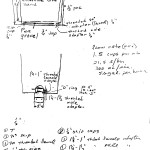Update December 8, 2013: The temperature got down to 10 degrees F here last night – this was the last measurement we had, it is likely that the temp was lower than that (we are not actually in Seattle, we are way out east and north of the city in the Cascade mountain foothills of northwest Washington state). For a while there was a breeze which put the wind chill below zero for sure. This was unusually cold weather. All of the filters that were running here, including filter 2 and 3, are frozen solid and major damage is expected. It may well be several months before anything can be done, and will likely be the middle of March, 2014 before any of the filters will be producing filtered water output. This cold was a surprise; we did not expect the temps to go this low. The pipes on filter 2 and 3 were wrapped and the pump had a heater, so the water flowing through the system was warmed. This did not help, the filters still froze. When I checked, it looked as if the top surface of the water freezing over caused the float valves to malfunction, which then disrupted the flow of warmed water through the filter. That was the beginning of the end. Once the water stopped flowing everything except the pump froze solid. (The pump and pressure tank were in a heated enclosure) Now most of the pipes will be cracked and the filters will need to be emptied, and new output pipes installed. This is a major setback, and a major learning experience. Temperatures at or below 20 degrees F for more than several days will ruin one of these filters, unless they are kept above 32 degrees F and water flows through them continuously.
It is December 6, 2013 and all the filters here are now frozen, with the exception of filter 2 and 3. It is unsure if they will last much longer. The temp. has been below freezing at night for the past week; and barely 32 degrees F during the daytime. The temp. did not get above 28 deg F here today. Now the conditions are windy here and, and the forecast is for colder weather for the next 3 days. I do not know when the filters will start again; probably not until sometime early next year in January, if we are lucky. After they start, it will take at least 3 weeks until they are working. It is likely to be sometime in February before any more testing is done.

